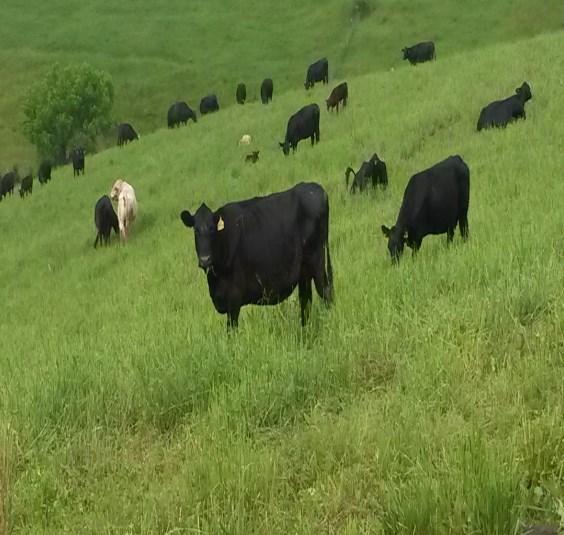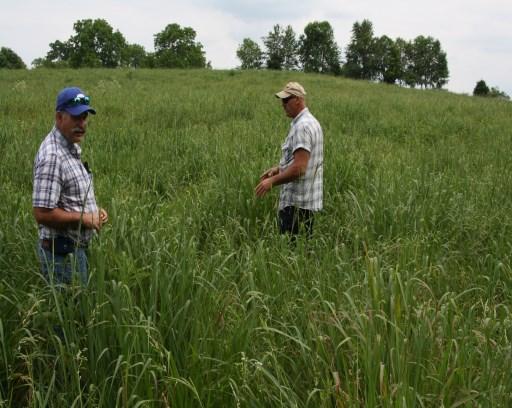Warm-Season Perennials
 Grazing warm-season perennials can be beneficial throughout the hot summer months. These forages have rapid growth rates during June, July and August while fescue and other cool-season forages exhibit limited growth. These forages do not contain the endophyte which results in fescue toxicity symptoms, such as heat stress and decreased fertility and performance. Yet many producers are hesitant to use warm-season perennials because of the seed, fertilizer, and fuel costs and loss of field production during estab-lishment. Grazing warm-season perennials may be a good option for those who want an alternative forage source during summer months and do not want to reseed annuals every year.
Grazing warm-season perennials can be beneficial throughout the hot summer months. These forages have rapid growth rates during June, July and August while fescue and other cool-season forages exhibit limited growth. These forages do not contain the endophyte which results in fescue toxicity symptoms, such as heat stress and decreased fertility and performance. Yet many producers are hesitant to use warm-season perennials because of the seed, fertilizer, and fuel costs and loss of field production during estab-lishment. Grazing warm-season perennials may be a good option for those who want an alternative forage source during summer months and do not want to reseed annuals every year.
Warm-season perennials grow best between late spring and early fall when temperatures are between 80° and 90°F. Warm-season grasses should be planted between mid-May and early-June after risk of frost. Seeds germinate when soil temperatures are above 55°F. These grasses should not be grazed during late August until frost to insure adequate amount of root carbohydrates for winter survival. Warm-season perennials are dormant throughout the winter and start to regrow when temperatures warm again in late spring. Potential for winter kill of some species is possible in Kentucky if temperatures get extremely low. Ask your extension agent about winter-hardy varieties that will decrease this risk. With proper management, stands with warm-season perennials may last 20 years or more. These forages are not preferred for high-producing dairy cattle or other animals with high nutritional needs, but supply adequate feed for bred dairy or beef heifers, dry dairy cows, sheep, goats, and beef cows. Most of the commonly planted native warm-season perennials are not recommended for horses.
When grazing warm-season perennials, leave at least 6 but preferably 12 inches of stubble. Overgrazing may lead to rapid stand loss. Do not leave livestock in an area for more than 5 days at a time, and allow 30 to 40 days of regrowth before grazing again. Rotational grazing of warm-season perennials can start once they reach 15 to 20 inches of height in spring. If livestock have to begin grazing when plants are shorter than 15 to 20 inches, cattle should stay in each paddock less time. Warm-season perennials can prove to be a valuable forage during summer months, while cool-season grasses are not growing.
The most common warm-season perennials used in Kentucky for grazing include native species, such as big bluestem, eastern gamagrass, Indiangrass, and switchgrass. The most common non-native warm-season perennial is bermudagrass.
 These warm-season species are slow to establish, and few herbicide options exist to control weed competition. Even with few herbicide options to control weeds, seeding should occur into a weed-free seedbed. The recommendation for preparing a seedbed is to till one month prior to seeding and lightly tilling again directly before seeding to kill newly sprouted weeds. Following the second tilling, use of a cultipacker will help kill weeds. The use of a no-till drill is possible if weeds are controlled. Another establishment method is to broadcast seed on a well prepared seedbed followed by cultipacking. Not planting seed too deep is important for stand survival as well. Seeding depth for these species are all ⅛ to ¼ inch except for eastern gamagrass, which has a seeding depth of ½ to 1 inch.
These warm-season species are slow to establish, and few herbicide options exist to control weed competition. Even with few herbicide options to control weeds, seeding should occur into a weed-free seedbed. The recommendation for preparing a seedbed is to till one month prior to seeding and lightly tilling again directly before seeding to kill newly sprouted weeds. Following the second tilling, use of a cultipacker will help kill weeds. The use of a no-till drill is possible if weeds are controlled. Another establishment method is to broadcast seed on a well prepared seedbed followed by cultipacking. Not planting seed too deep is important for stand survival as well. Seeding depth for these species are all ⅛ to ¼ inch except for eastern gamagrass, which has a seeding depth of ½ to 1 inch.
Many of the warm-season perennials are classified as bunchgrass. These plants are defined as native plants that grow as singular plants in large clumps (much larger than orchardgrass), rather than forming a sod or lawn. With large root systems, bunchgrasses can assist in slope stabilization, erosion control, and soil porosity. The large clumps of grass make travel across a field rough, causing driver discomfort.
Eastern gamagrass, a large bunchgrass is often preferred over other warm-season perennial grasses because of its quality and palatability with one of the longest growing seasons. This grass can be used for grazing, hay, or baleage. The eastern gamagrass seeds are large and enclosed in a cylindrical seed coat leading to high levels of seed dormancy, which can reduce germination. Peroxide or wet-chilling seed treatments may be necessary to increase germination, and many companies offer this type of seed. Eastern gamagrass should be planted in 30" rows with a corn planter and not be grazed the first year.
Big bluestem is a tall growing bunchgrass used for hay and grazing. Although big bluestem has a lower yield potential than switchgrass, it has a higher forage quality and more tolerant of poor soils and drought. Like eastern gamagrass, big bluestem has a high palatability and digestibility. A specially modified seed hopper mounted to the seeder may be needed or seed will need to be debearded prior to seeding. This grass is often preferred for hay production as it dries quickly and produces high quality hay.
Switchgrass is a tall growing grass that produces short rhizomes so that individual plants can increase in size over time. This warm-season perennial is often used for grazing and hay. As it matures, the stems quickly become thick and quality declines rapidly. Harvesting at an immature stage, while stems are short and thin and more digestible, is important for forage quality. Switchgrass can be seeded easily with most drills. This grass is used for biomass production.
Indiangrass is a tall growing bunchgrass with yields comparable to big bluestem but less than eastern gamagrass and switchgrass. It produces most of its growth later in summer when other species are starting to decline. As it matures, Indiangrass gets a thick stem and digestibility and quality decrease. Because the stem thickens with maturity, Indiangrass should be grazed during the vegetative stage. This very drought tolerant species grows better than others on steep, shallow soils and is a good wildlife habitat. Like big bluestem, seed needs to be debearded before seeding unless a modified seed hopper is used. Indiangrass is often overlooked by many producers, but when it is used, it is often planted in a mixed stand with big and little bluestem.
Bermudagrass, a sod-forming grass used for grazing and hay, is often preferred due to its ability to produce high yields of good quality forage and its tolerance to high traffic. Sprigging and seeding are methods use to establish bermudagrass. This forage requires high nitrogen fertility to achieve the high yielding potential of the grass. Applying 50 to 100 lbs. of nitrogen is needed in mid-May after “green up” and then 50 lbs. of nitrogen every 30 days or following each hay cutting is common. Various varieties can only be planted by sprigging as they do not produce viable seed. Sprigging is the process of incorporating rhizomes and stolons into a prepared seedbed by using specialized equipment. Sprigs should not planted over ¼ inch deep. Cultipacking after sprigging firms soil and improves establishment. Seeded varieties should be planted into a prepared seedbed. Most varieties have a good winter survival rating under KY conditions.
For more information on the native grasses, see AGR-145: Native Warm-Season Perennial Grasses for Forage in Kentucky. For more information on Bermudagrass, see AGR-48: Bermudagrass: A Summer Forage in Kentucky.
Categories:
Summer
Species/Varieties


